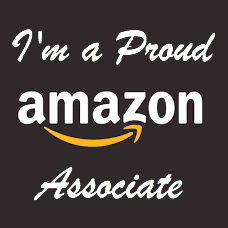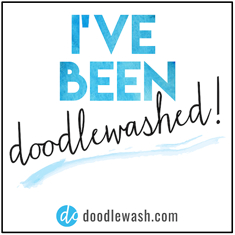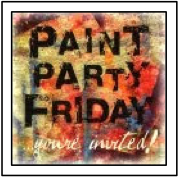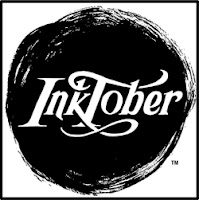 |
| )Quinacridone colors from Daniel Smith) |
 All of the above helped whittle down my color choices to something manageable but it did still leave me with many, many choices. So the only way to make decisions is to break it down to smaller pieces. I know I wanted cool and warm choices in each primary color and I knew that I had twenty-four spaces in my Whiskey Painter's Master Palette (to be purchased from Wet Paint in the near future with the Daniel Smith watercolors, read: Christmas!) Ok, so I knew I'd have at least six colors there. But I also knew that I wanted to have a broad selection each of yellow, red and blue, the primaries. So really, that meant that at least nine and probably twelve of the spaces would be taken up. Then I knew I had some favorite colors that were going to be personal choices (potter's pink, buff titanium, lunar violet, maybe even payne's grey), so that would get me to about sixteen. I'd have eight spaces left to fill in "gaps" I saw or extra colors that really intrigued me like more quinacridones! Oh, and also, I knew I'd want a viridian type color and a sap green for convenience. Now we're up to eighteen plus extra quins. So far, so good.
All of the above helped whittle down my color choices to something manageable but it did still leave me with many, many choices. So the only way to make decisions is to break it down to smaller pieces. I know I wanted cool and warm choices in each primary color and I knew that I had twenty-four spaces in my Whiskey Painter's Master Palette (to be purchased from Wet Paint in the near future with the Daniel Smith watercolors, read: Christmas!) Ok, so I knew I'd have at least six colors there. But I also knew that I wanted to have a broad selection each of yellow, red and blue, the primaries. So really, that meant that at least nine and probably twelve of the spaces would be taken up. Then I knew I had some favorite colors that were going to be personal choices (potter's pink, buff titanium, lunar violet, maybe even payne's grey), so that would get me to about sixteen. I'd have eight spaces left to fill in "gaps" I saw or extra colors that really intrigued me like more quinacridones! Oh, and also, I knew I'd want a viridian type color and a sap green for convenience. Now we're up to eighteen plus extra quins. So far, so good.I knew I wanted a couple turquoise colors because I LOVE turquoise and I'd probably add a brown color and a purple of some sort for ease of use. I mean, you should learn to mix colors yourself, that's what makes a good painter but ease of use also has to fit in there too, it's a balance. If you're keeping up with me, we're at about twenty-one or twenty-two colors. That's close enough, the other colors, I'm sure, will fill themselves in easily.
So, on to actually choosing primaries, warm and cool... I did a spread sheet to see what colors everyone seemed to like and, of course, I tested all the 238 dots! I also added in my own slant on color that I'd developed in the last couple of months as I tested my temporary travel palette and surprisingly, ended up with less conflict than I thought I would. I mean, geez, I had potentially like two hundred colors to choose from, lol. But taking out colors I didn't respond to, colors that didn't have the qualities I was looking for (lightfast, transparent, bright & gorgeous!) and colors that seemed like I could mix by having enough of a range of reds, blues and yellows made the choice much, much easier than I thought.
(Below are more examples of the the palettes from the artists I've mentioned)
 |
| (Liz Steele's Palette) |
Cadmium Yellow Medium Hue
New Gamboge
Permanent Alizarin Crimson
Cadmium Red Medium Hue
Sap Green
French Ultramarine
Burnt Umber
Opera Pink
Cobalt Teal Blue
Imperial Purple
I found myself with this list of colors:
Warm Reds:
- Transparent Pyrrol Orange (when I learned that this was a good warm red I jumped on it like a chicken on a june bug! I LOVE it's brightness and it gave me an excuse to use it)
- Pyrrol Red (ended up being the one I liked the most for a good red)
- Quin Red OR Quin Pink (I'm getting both, not sure which one I'll like best over time)
Opera Pink(I was SO disappointed when I discovered, in the middle of this process, that my favorite pink ever was totally fugitive, a rating of IV for lightfastness is BAD)- Quin Magenta (such a great color signally and as a mixer, so darn bright itself that it mixes perfectly with my Hansa Yellow and Phthalo blue and Transp. Pyrrol Orange to make spectacular complimentary colors, go to Jane Blundell to see what I mean)
- New Gamboge (I knew I needed a darker yellow than the cadmium I'm using and I knew I wanted to get rid of the opaque cads anyway so this suggestion from Roz was perfect)
- Quin Gold (such a perfect mixing color, I may not need the yellow ochre I have below because of this color but I'm new to this so I hedged my bets and left both in my palette, yellow ochre may be leaving at some point, we'll see)
- Hansa Yellow Medium (everyone agrees that this is a perfect near neutral, read: not warm or cool yellow. Roz also suggests Azo Yellow if you prefer)
- Ultramarine (LOVE this blue, it's granulating which is a plus when using it to do water, it mixes perfectly with burnt Sienna to make a great black and with more Ultramarine than sienna, a beautiful Payne's grey)
- Indanthrone Blue (PB60) (I needed a dark blue and this is a favorite everywhere I look and I love it too, beautiful depth... and indigo is opaque so PB60 it is!)
- Phthalo Blue (Red Shade) (This is almost a neutral blue, read: not warm or cool, and since I love how it fits in the palette and mixes with hanse, Q.Magenta and Trans. Pyrrol Orange I just had to have it. I also believe having more blues makes color mixing easier)
- Cerulean Blue (Chromium) (my softer blue, although it is an opaque color, I love it for it's lightness and it's good to have a few opaque colors just like having some colors that granulate, mix it up a little!)
- Cobalt Teal (Ok, here me now. I LOVE turquoise/ teal. I can't get enough. My personal triad, what I dress in & do my house in is sap green, quin. magenta and turquoise. Nuff said.)
- Phthalo Turquoise (Didn't you hear me the first time? See above, lol.)
- Quin Burnt Orange (takes the place of Burnt Sienna in my palette right now. I had two 15ml tubes given to me for free so I intend to use them up before thinking of switching to burnt sienna. BS is a perfect pair with PB60, making the most luscious warm grays ever.)
- Yellow Ochre (hedging my bets color. Also, my mom used to paint with it and LOVES it so it stays in the palette for now)
- Naphthol Maroon (a good darker color that I can tame some of the bright ones with)
- Quin Purple (Love it and want a dark purple, also the more quinacridone colors I can get into my palette, the happier I'll be)
- Sepia (has been a favorite since I started learning that ink didn't just have to be blue, black and red! I love a good brown and it makes other rich browns with the addition of quin burnt orange, quin red or transp. pyrrol orange)
- Potter's Pink (hard to mix this color, good for many things including skin)
- Buff Titanium (same as above, hard to mix, good for rocks, sand, skin etc.)
- Sap Green (I allowed myself my most common green for it's own color and for mixing)
- Lunar Black (I found a black that is TRANSPARENT!!!)
- Lunar Violet (Since I'm not allowing myself my favorite Payne's gray as I can so easily mix it using Ultramarine + Quin Burnt Orange/Burnt Sienna, I decided to allow myself another very beautiful and unusual gray. You'll love it too, WOW.)
- Phthalo Green (Blue Shade) (I have always loved viridian but Daniel Smith's kinda sucks, it's really weak so this steps in for viridian, just terrific powerful color and great mixer)
 |
| Daniel Smith Dots |
 |
| Daniel Smith Dots (I only tested a few iridescent/interference colors, they're right lower section) |
 When choosing a few of the reds/pinks I found myself having the most trouble in my palette creation. When my Opera Pink turned out to be fugitive I was devastated and also a little panicky because I had already finished choosing all the other colors. In fact, I'd done the painting of my new palette and everything, including the fugitive opera in it! I wasn't sure if taking opera out meant that all the quin pinks had to change. One doesn't want to repeat a color too closely, you're wasting valuable real-estate by doing that and I was already being wasteful by hedging my bets between quin gold and yellow ochre. SHeesh!
When choosing a few of the reds/pinks I found myself having the most trouble in my palette creation. When my Opera Pink turned out to be fugitive I was devastated and also a little panicky because I had already finished choosing all the other colors. In fact, I'd done the painting of my new palette and everything, including the fugitive opera in it! I wasn't sure if taking opera out meant that all the quin pinks had to change. One doesn't want to repeat a color too closely, you're wasting valuable real-estate by doing that and I was already being wasteful by hedging my bets between quin gold and yellow ochre. SHeesh! So, when I looked, I decided to leave the palette the way it was but just take out Opera and replace it with a great purple that I had decided I would mix using all my beautiful blues and quin magenta or quin red. But with Opera officially given it's walking papers I had an open space and oh what a valuable space it is! In went a great purple, Quin purple to be exact. The good thing was I didn't even have the quin violet in there so I wasn't getting colors too close to each other in value, shade or temperature. The one bad thing was that it wasn't a dot on my dot sheets so I couldn't test it or add it into the square where I'd removed (literally) the Opera. So, I mixed it using a tiny bit of phthalo blue and it's closest neighbor, quin violet. Good to go, but it does look a little muddy in the palette as I "lifted Opera first (and Stillman & Birn Zeta paper doesn't like that!) then added the mix on top of that hot mess. Ok, one more SHEESH!!
 Value = the lightness or darkness of a color
Value = the lightness or darkness of a colorShade = darkening a color using black or the color's compliment
Temperature = warmth or coolness of a color. Reds & yellows are warm, greens & blues are cool.
To learn more about colors and mixing them and everything we've been talking about, Stephen Quiller wrote the best book, an artist's bible. It's called Color Choices. Also, the website HandPrint is a really helpful resource too, I've hardly touched the surface there. I'm learning so much by using all the artists I mentioned above, especially Roz Stendahl and Jane Blundell. Also, if you go to Jane's website (as opposed to her blog) and click on "Tutorials & Resources" you can learn SO MUCH about watercolors you'll amaze yourself. I'm still perusing it from time to time, trying to remember everything I'm reading at roz's and Jane's place. So, that's it for color theory today, aren't you glad you stopped by? LOL.
Oh, I forgot to mention, when I ordered the DS dots from Wet Paint I also had the happy coincidence of being able to pick up a couple of the Richardson Kids Palettes that Roz mentioned when I took Sketchbook Skool. These little gems are so cheap at less than three dollars each. You now have NO excuse not to take some watercolors with you when you go out to draw! All you do is pop out the kid paint and fill with eight of your own colors (warm+cool red, warm+cool blue, warm+cool yellow and two other colors, like sap green and Burnt Sienna or Payne's grey for instance= 8 colors). Ok, here, I'll help, here's a limited palette of the above that I would do after all this research...
- warm yellow - quinacridone gold
- cool/neurtral yellow - Hansa Yellow medium
- warm red - Transparent Burnt Orange
- cool red - Quinacridone Red OR Quinacridone Rose
- warm blue - Ultramarine Blue
- cool blue - Phthalo Blue OR Prussian Blue
- extra color #1 - Sap Green
- extra color #2 - Burnt Sienna
Best,
If you're looking for this week's APR just click here.
Tweet this Post





























Oh my!I feel like I have found a treasure chest.So much of useful information.I will probably have to go over it multiple times to get used to the shade names and the properties.I can't wait to be better at watercolours and then justify buying some good ones.Sigh,when will that happen!
ReplyDeletehoney, you can get all the wordy you want! i read every word and want more! now to go find those dots and see about getting me some to play with . . . . . .
ReplyDeleteThis is a very good post. I enjoyed it as well.
ReplyDeleteNicole/Beadwright
sadly, the dot sheets are backordered, but i should have them in a week or so. yay!!!! i ordered some new journals, too, cause you can never have too many :)
ReplyDelete